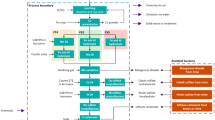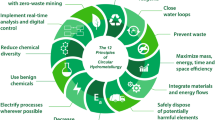Abstract
Corrosion reduces the lifetime of municipal solid waste incineration (MSWI) superheater tubes more than any other cause. It can be minimized by the careful selection of those materials that are most resistant to corrosion under operating conditions. Since thousands of different materials are already known and many more are developed every year, here the selection methodology developed by Prof. Ashby of the University of Cambridge was used to evaluate the performance of different materials to be used as MSWI superheater tubes. The proposed materials can operate at steam pressures and temperatures over 40 bars and 400 °C, respectively. Two case studies are presented: one makes a balanced selection between mechanical properties and cost per thermal unit; and the other focuses on increasing tube lifetime. The balanced selection showed that AISI 410 martensitic stainless steel (wrought, hard tempered) is the best candidate with a good combination of corrosion resistance, a relatively low price (0.83-0.92 €/kg) and a good thermal conductivity (23-27 W/m K). Meanwhile, Nitronic 50/XM-19 stainless steel is the most promising candidate for long-term selection, as it presents high corrosion resistance with a relatively low price (4.86-5.14 €/kg) compared to Ni-alloys.






Similar content being viewed by others
References
I.G. Wright and H.H. Krause, Assessment of Factors Affecting Boiler Tube Lifetime in Waste-Fired Steam Generators: New Opportunities for Research and Technology Development, ASME, New York, 1994, p 1–112
H.J. Grabke, E. Reese, and M. Spiegel, The Effects of Chlorides, Hydrogen Chloride, and Sulfur Dioxide in the Oxidation of Steels Below Deposits, Corros. Sci., 1995, 37, p 1023–1043
Y.S. Lia, M. Spiegel, and S. Shimada, Corrosion Behaviour of Various Model Alloys with NaCl-KCl Coating, Mater. Chem. Phys., 2005, 93, p 217–223
A. Zahs, M. Spiegel, and H.J. Grabke, Chloridation and Oxidation of Iron, Chromium, Nickel and Their Alloys in Chloridizing and Oxidizing Atmospheres at 400-700°C, Corros. Sci., 2000, 42, p 1093–1122
Y. Kawahara, High-Temperature Corrosion Mechanisms of Fe-Based Alloys in NaCl Containing Atmospheres, Corros. Sci., 2002, 44, p 223–245
M. Morales, J.M. Chimenos, F. Espiell, and M. Segarra, The Effect of Temperature on Mechanical Properties of Oxide Scales Formed on a Carbon Steel in a Simulated Municipal Solid Waste Incineration Environment, Surf. Coat. Technol., 2014, 238, p 51–57
J. Stringer, Performance Limitations in Electric Power Generating Systems Imposed by High Temperature Corrosion, High Temp. Technol., 1985, 3, p 119–134
D.B. Meadowcroft, Some Critical Industrial Requirements and Experience Related to High-Temperature Corrosion, Mater. Sci. Eng. A, 1989, 121, p 669–675
H.H. Krause, Effects of Flue-Gas Temperature and Composition on Corrosion from Refuse Firing, Corrosion NACE International, 1991, 242, p 6-10
Y. Kawahara, Recent Trends in Development and Application of High-temperature Corrosion-Resistant Materials and Coatings in High Efficiency Waste Incineration Boiler, MTERE2 41, 2002, p 190-194
J. Wandschneider, U. Seiler, G. Hölter, and T. Wilmann, Increase of the Electrical Energy Efficiency to 30% Due to a High Performance Boiler—Example of HR-AVI-Amsterdam (Steigerung des elektrischen Wirkungsgrades bis 30% durch eine Hochleistungskesselanlage am Beispiel der HR-AVI-Amsterdam), Optimization in Thermal Waste Treatment (Optimierung der Abfallverbrennung) 1, K.J. Thomé-Kozmiensky and M. Beckmann, Ed., Neuruppin. TK Verland Karl Thomé-Kozmiensky, Neuruppin, 2005, p 1–15
Y. Kawahara, M. Nakamura, H. Tsuboi, and K. Yukawa, High Efficiency Waste-to-Energy Plants, Corrosion, 1998, 54, p 576–589
P. Rademakers, W. Hesseling, and J. van de Wetering, Review on Corrosion in Waste Incinerators, and Possible Effects of bromine, TNO Industrial Technology, 2002, p 18-25
W.T. Bakker, The Effect of Chlorine on Mixed Oxidant Corrosion of Stainless Steels, Mater. High Temp., 1997, 14, p 197–205
M. Noguchi, H. Yakuwa, M. Miyasaka, M. Yokono, A. Matsumoto, and K. Miyoshi, Experience of Superheater Tubes in Municipal Waste Incineration Plant, Mater. Corros., 2000, 51, p 774–785
E.P. Latham, D.B. Meadowcroft, and L. Pinder, Coextrusion Cladding for Oxidation Protection, Mater. Sci. Technol., 1989, 5, p 813–815
U. Brill and G.K. Grossmann, Corrosion Behavior of Weld Overlays of the New Alloy 50, Corrosion, 2001, 170, p 11–16
J. Stringer, Coatings in the Electricity Supply Industry: Past, Present, and Opportunities for the Future, Surf. Coat. Technol., 1998, 1, p 108–109
S.T. Bluni and A.R. Marder, Effects of Thermal Spray Coating Composition and Microstructure on Coating Response and Substrate Protection at High Temperatures, Corrosion, 1996, 52, p 213–218
M.S. Brennan and R.C. Gassmann, Laser Cladding of Nickel and Iron Base Alloys on Boiler Waterwall Panels and Tubes, Corrosion, 2000, 235, p 26–31
J.R. Hayes, J. Gray, A.W. Szmodis, and C.A. Orme, Influence of Chromium and Molybdenum on the Corrosion of Nickel Based Alloys, J. Electrochem. Soc., 2005, 62, p 491–494
K. Nakagawa, Y. Matsunaga, and K. Yukawa, An Electrochemical Investigation of Corrosion of Superheater Tube in Waste Incineration Environment, Corrosion, NACE International, 1997, p 1–10
H. Lefaix-Jeuland, L. Marchetti, S. Perrin, M. Pijolat, M. Sennour, and R. Molins, Oxidation Kinetics and Mechanisms of Ni-Alloys in Pressurised Water Reactor Conditions: Influence of Subsurface Defects, Corros. Sci., 2011, 53, p 3914–3922
T. Ishitsuka and K. Nose, Solubility Study on Protective Oxide Films in Molten Chlorides Created by Refuse Incineration Environment, Mater. Corros., 2000, 51, p 177–181
A. Nishitasanwichka and S. Haruyama, Electrochemical Monitoring of the Corrosion of Ni, Fe, and Their Alloys in Molten Salts, Corrosion, 1986, 42, p 578–584
M.F. Ashby, Multi-objective Optimisation in Material Design and Selection, Acta Mater., 2000, 48, p 359–369
K.L. Edwards, Designing of Engineering Components for Optimal Materials and Manufacturing Process Utilization, Mater. Des., 2003, 24(5), p 355–366
M.F. Ashby, Y.J.M. Bréchet, D. Cebona, and L. Salvo, Selection Strategies for Materials and Processes, Mater. Des., 2004, 25, p 51–67
K.L. Edwards, Selecting Materials for Optimum Use in Engineering Components, Mater. Des., 2005, 26, p 469–473
K.L. Edwards, Materials Influence on Design: A Decade of Development, Mater. Des., 2011, 32, p 1073–1080
M.F. Ashby, Materials Selection in Mechanical Design, 3rd ed., Elsevier Butterworth-Heinemann, Oxford, 2005, p 8–160
CES Selector 2012 Software, Granta Design Ltd, Cambridge, 2012
M.F. Ashby, H. Shercliff, and D. Cebon, Materials: Engineering, Science, Processing and Design, 2nd ed., Butterworth Heinemann, Oxford, 2010, p 203–224
G.E. Dieter and H.A. Kuhn, Handbook of Workability and Process Design, ASM International, Materials Park, OH, 2003
J. Olsson, A Stainless Steel for Condenser Tubes, UNS S32654, Avesta Sheffield AB, S-774 80 Avesta, Sweden, 2010, p 27-89
G. Gemmel, Properties, Specifications and Experience of Welded Stainless Steel Pipes in the Grades UNS S31254, N08904, S32304, S31803 and S32750, M Sc. Metallurgy Manager Market Development Avesta Sandvik Tube AB 64421 Torshälla, Sweden, 2010
Special Metals Corporation, A Comparison of the Properties of Corrosion-Resistant Alloys and Titanium: An Aid for Specifying Cost Effective Materials for Demanding Applications, Special Metals Corporation, 3200 Riverside Dr. Huntington, WV 25705-1771 USA, 2005
S.A. McCoy, B.C. Puckett, and E.L. Hibner, High Performance Age-Hardenable Nickel Alloys Solve Problems in Sour Oil and Gas Service, Special Metals Corporation, 3200 Riverside Dr. Huntington, WV 25705-1771 USA, 2002
J.R. Crum, L.E. Shoemaker, and S.D. Kiser, Special Alloys and Overmatching Welding Products Solve FGD Corrosion Problems, Special Metals Corporation, 3200 Riverside Dr. Huntington, WV 25705-1771 USA, 2010
B.A. Baker, G.D. Smith, and L.E. Shoemaker, Performance of Commercial Alloys in Simulated Waste Incineration Environments, Special Metals Corporation, 3200 Riverside Dr. Huntington, WV 25705-1771 USA, 2010
DIN 17175-79 standard: Seamless Steel Tubes for Elevated Temperatures, DIN Deutsches Institut für Normung e. V, 1979
C.X. Li and T. Bell, Corrosion Properties of Plasma Nitrided AISI, 410 Martensitic Stainless Steel in 3.5% NaCl and 1% HCl Aqueous Solutions, Corros. Sci., 2006, 48, p 2036–2049
M.J. Walter, Stainless Steel for Medical Applications, Adv. Mater. Process., 2006, 22, p 84–86
R.P. Anantatmula, S.J. Mayhan, and P.A. White, Microstructural Characterization of Advanced Ferrous Alloys Exposed to Liquid Sodium, Annual Technical Meeting of the International Metallographic Society, Houston, TX, USA, 1977
N. Wanderka, V. Naundorf, J. Banhart, D. Mukherji, D. Del Genovesse, and J. Rodsier, Microstructural Characterization of Inconel 706 alloy, Surf. Interface Anal., 2004, 36, p 546–551
D.J. Coates, B. Mortimer, and A. Hendry, The Oxidation and Corrosion Resistance of Nitrided Iron Alloys, Corros. Sci., 1982, 22, p 951–972
Acknowledgments
The authors thank R. Nadal (General Manager of SIRUSA) and the SIRUSA Incineration Plant for useful discussions and for financing this work, and Mrs. Toffa Evans of the Language Services of the University of Barcelona for language revision. This study was also financed by the Spanish MICINN under the ENE2011-28269-C03-02 Project, and XaRMAE (Xarxa de Referència en Materials Avançats per l’Energia, Generalitat de Catalunya).
Author information
Authors and Affiliations
Corresponding author
Rights and permissions
About this article
Cite this article
Morales, M., Chimenos, J.M., Fernández, A.I. et al. Materials Selection for Superheater Tubes in Municipal Solid Waste Incineration Plants. J. of Materi Eng and Perform 23, 3207–3214 (2014). https://doi.org/10.1007/s11665-014-1100-y
Received:
Revised:
Published:
Issue Date:
DOI: https://doi.org/10.1007/s11665-014-1100-y




